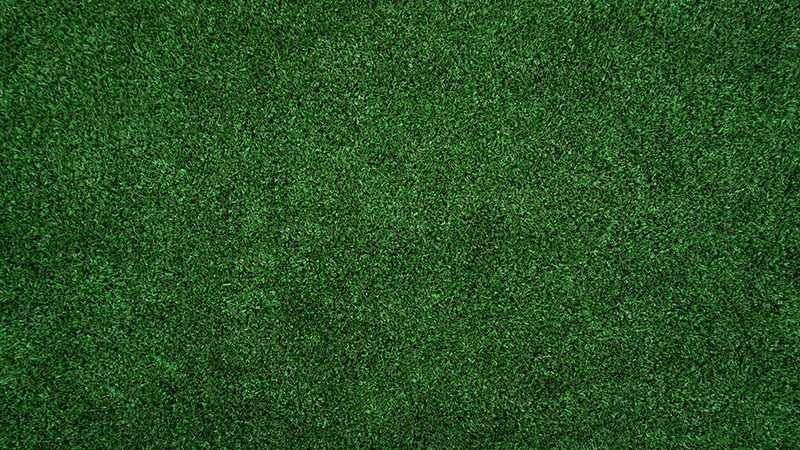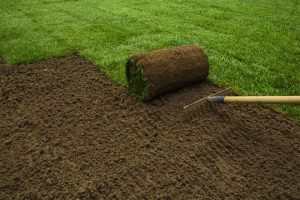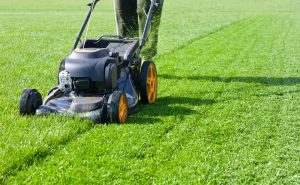
How Do You Keep Zoysia Grass Green?
It doesn’t matter if you’re an expert in lawn care or just getting started. We all want the same thing from our Zoysia grass: a deep green lawn. There are many ways to achieve this. Where you live can also have an impact on the outcome, especially if you are in the Southeast. Luckily, we are here to offer you tips and tricks to guide your green thumb to a deep green lawn.
Here are five steps to keeping your Zoysia in great shape for a healthy, deep green lawn.

Starting with healthy sod gives you an instantly lush, deep green lawn.
SOD
When you want an instant lawn, it’s best to install Zoysiagrass sod. Opting for sod versus seed helps reduce weed populations which can occur in bare spots. Make sure the soil is properly prepared before sodding. Sod should be laid on moist, bare soil, then rolled after laying. You should water the sod lightly every day until the roots are incorporated into the soil. Once the roots are established, you can reduce your watering frequency. The pros at Turfgrass Group can help you find an expert Zoysiagrass grower in your area.
FERTILIZE
Sodding Zoysiagrass also requires “feeding.” But nutrients often evaporate from the soil when your lawn is watered or rained on. Your grass will grow thicker and healthier with regular fertilization during the growing season.
The need for fertilizer varies based on the square footage and climate. Typically, Zoysia grass requires only minimal nitrogen, about 1 pound per 1,000 square feet during the growing season. However, it will maintain a better color in cool weather if fertilized during the fall. e.
IRRIGATE
After your lawn has thickened, follow good lawn watering practices to keep it strong and thick. Growing sod requires constant moisture until seedlings emerge and fill in between existing grass. If you live in the Southeast, you likely benefit from a lot of rainfall. Whether you use an irrigation system or nature to water your lawn, keep track of how much water your lawn is getting. Zoysiagrass typically needs about one inch of water a week once it is established. Irrigating deeply and thoroughly encourages deeper root growth, which thicker lawns require.
Your grass will be able to withstand heat, drought, and stresses that can make ordinary grasses struggle to grow. The benefits of Trinity® L1F and JaMur™ Zoysia are that these are both water-conserving, tough, and easy-to-maintain varieties.
MOW
Your Zoysiagrass will stay thick and lush when you use the best mowing techniques. Mow according to what your grass requires rather than based on your weekly calendar. Maintain the recommended height of your grass with frequent mowings that do not remove more than one-third of the height in one pass. Keeping your lawn well-watered can help avoid problems like thin, unattractive lawns.
You must maintain your mower, so the grass blades come out clean rather than torn up. Zoysia grows thick, making it tougher to mow. And grass that becomes ragged or torn from dull mower blades is more likely to become infested with insects, pests, and common lawn diseases. It is also important to switch your mowing pattern regularly to ensure that grass stays straight and thick.
CONTROL
It is difficult for grass to compete with weeds for light, water, and nutrients. The grass is less likely to receive fertilizer and other resources if you have more weeds. For grass to stay thick and well-nourished, weeds must be controlled to eliminate competition. Taking care of common lawn weeds early in the fall is a good idea. Zoysiagrass is particularly sensitive to some herbicides during the hot summer months, so follow instructions on any product you purchase.
Incorporate these tips and best practices into your weekly lawn maintenance schedule or weekend lawn overhaul. This way, you can ensure a thick, lush lawn and maintain it for years to come.
Zoysia FAQs
Now that you know how to prepare and care for your Zoysia lawn, here are some answers to your most frequently asked Zoysia questions.
Is Zoysia grass better than Bermuda?
It depends on your property and your needs. Nothing is going to look greener and feel softer than high-quality Zoysia. Most people think Zoysia is more attractive than Bermuda grass. It has less blue in its green and grows more upright. Additionally, if your property has trees that cast shade on your lawn, Zoysia is a better choice. Along with shade tolerance, Zoysia makes a tighter sod than Bermuda or buffalo grass, so it is better at resisting weeds. However, one knock against Zoysia is that it is the hardest grass variety to mow.
When should Zoysia green up?
In the spring, your Zoysia grass will green up about ten days after the temperature is steadily above 32 degrees Fahrenheit. Zoysia grass conserves its energy until the temperatures are consistently warm, which is usually mid to late spring.
What is the best time of year to plant zoysia?
The best times to plant Zoysia grass are in late spring and early summer. Plant when daily temperatures are consistently hovering around 70 degrees Fahrenheit. Zoysia planting can also be done in early fall, so long as you make sure to plant it at least 60 days before the first fall frost.
Will Zoysia take over other grasses?
Because Zoysia is a spreading grass, it is known to overtake other grasses and weeds. The fact that it can overtake weeds is usually seen as a big positive. However, if your lawn is near other types of grasses or plants, you may need to control and maintain it.
Is Zoysia grass hard to maintain?
As long as you follow good maintenance practices, your Zoysia lawn will do fine. However, the biggest maintenance concern with Zoysia is mowing. Zoysia grass requires frequent mowing and can thicken and become difficult to mow. But that thickness is what makes the lawn appear lush and deep green!
To keep your lawn looking attractive, you should mow zoysia grass to 1/2 to 1 inch high once or twice every week in the summer. If you do not mow often enough, the thickened grass will give your lawn a puffy appearance. To maintain an attractive lawn, you may have to switch from a rotary mower to a reel mower to avoid scalping or cutting your Zoysia grass too short.
Why is Zoysia grass so expensive?
Zoysia is typically more expensive than Bermuda grass. But when you consider all the benefits, cost aside, Zoysia grass wins every time. The price reflects the quality of the sod and the hard work that has gone into engineering it. Zoysia grass has been developed using the latest plant breeding technology to create a grass that delivers quality all year round. It is shade tolerant and hardy. It is designed to require less watering and less fertilizer.

Avoid mowing a lawn too short, which can damage grass roots.
What height should you cut zoysia grass?
When mowing Zoysia grass, the recommended height is 1.5 to 3 inches. However, you will not need to mow nearly as often as with other grass types because Zoysia doesn’t grow tall quickly, rather it spreads out. A general best practice rule when mowing any turf is never to cut more than 1/3 of the leaf height.
Zoysia: A Deep Green Lawn That Stays That Way
The lush, velvety look of a green lawn can enhance any landscape. Your Zoysia lawn will remain healthy and lush nearly all year long when properly cared for. That’s why it’s so important to maintain your lawn properly.
Our certified Zoysia grass growers provide sod with reliable performance and exceptional value to your home. And with a little love, patience, and elbow grease, you can achieve and maintain a deep green lawn. Start your Zoysia grass lawn today!
